Ten years ago Patrick White had a problem. A wall was collapsing adjacent to one of the lock-up garages on his property. He needed access to repair it, so he contacted the garage’s keeper, David Kinsella – who’d had it for some 40 years – and was granted access.
When they peeped in through the door, Patrick’s brother Dan said, ‘I think there are two Allards in there.’ He subsequently consulted Allard enthusiast Mike Knapman when it transpired that Mr Kinsella hadn’t visited the garage in quite a while and may be open to offers on its contents.
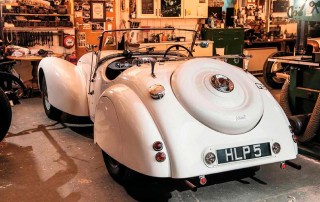
‘There was an M-type drophead coupé that looked well-preserved,’ Patrick recalls, ‘and next to it a depressing pile of old bits. The advice from Mike was to ignore the car and buy the pile of old bits.’
The reason for this was that Mike thought this chassis, body and heap of parts was HLP 5, a 1946 Allard J1 originally owned and campaigned by AG ‘Goff’ Imhof, a wealthy enthusiast who acted as a consultant to Allard. Confirming the identity and restoring the battered remains were twin challenges that Patrick and Mike would have to overcome.
Imhof’s account of a part-sporting, part-gastronomic trip through Belgium, France and Switzerland in HLP 5 was deemed worthy of two four-page features in the November 22 and 29 issues of Autocar in 1946. He began entering rallies and trials not long after returning to the UK, but HLP 5’s competition career peaked the following May when the Allard Motor Company took out a fullpage advertisement to announce Imhof’s victory in the Lisbon Rally with Ken Hutchison as co-driver. Magazine evidence dwindles after this, so it was up to Mike to pull the threads together.
He knew that HLP 5 became part of Imhof’s Candidi Provocatores trials team, but by 1948 Imhof was trialling a J1 with a rough, box-like body that placed the bouncer well behind the driver to exploit a loophole in regulations. It’s been suggested that this car, which was registered KLD 5, was actually HLP 5 rebodied following a collision with a stone wall on a trial in Derbyshire, but this now seems unlikely.
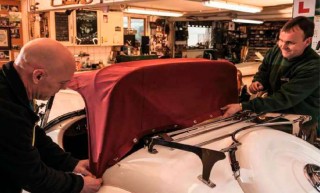
Mike has located a Service Department record from October 27 1948 that includes an entry for HLP 5: ‘Two new wings and sidelights, re-fit rear numberplate, steering links, de-coke and tune.’
These appear to be entirely appropriate repairs following a collision, but it seems like a lot of trouble to go to for a car that’s about to have its entire body replaced. And in any case, if it was re-bodied at this point, there’s still no explanation for why it would have been re-registered as KLD 5.
‘Personally, I think that HLP 5 was probably tidied up, put back on to its wheels and rolled unceremoniously into the shadows,’ says Mike. An Allard with a 1172cc Ford sidevalve engine and various other modifications known as the Murray Special was advertised in Wimbledon in 1964. A man called Peter Valentine recognised its J1 production body and suspected that it may be the Imhof car, albeit much messed about with. He in turn sold it for £10 to a young Mike Knapman, but he never got around to restoring it and sold it to David Kinsella in 1967 or ’68. Kinsella dismantled it and put it in a garage that would one day be on Patrick White’s property. No wonder Mike was able to identify the bits.
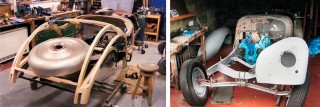
The detective work continued when he stripped and examined the remains and found chassis damage and a bent stub-axle that would fit with the Derbyshire crash. Knapman describes the process of elimination that led him to identify HLP 5.
‘There were only ever four Allard J1s with production bodies. Sydney Allard used one in sprints until at least 1951. Trials drivers Ken Burgess and Jim Appleton each had one – both of which survive today – and then there’s HLP 5. Only these four J1 production cars have doors that follow the curve of the rear wing and there were other details, such as catches for hanging jerry cans on the side during long rallies and a radio aerial. The aerial would be a particularly bizarre thing to put on an open sports car from 1946 – unless you were the wealthy owner of a radio and phonograph company. Which is exactly what Imhof was.’
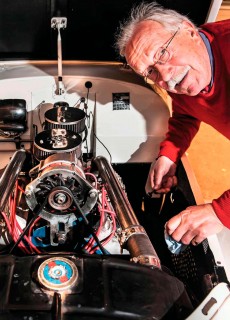
With this evidence, together with support from the Allard Owners’ Club, Mike and Patrick were able to reclaim HLP 5’s registration number and identity from the DVLA.
‘I remember asking Mike how long it would take to restore, back at the beginning,’ says Patrick. ‘I suggested three years and he said, “No, more like five”. It was actually seven at the finish.’
Work got underway when Patrick asked an experienced mechanic called Bob Threader to blast the chassis and clean up some of the other parts. After this it went to Mike, who set about the long process of turning it from a bare frame into a rolling chassis. He carefully stripped, examined, repaired and rebuilt all the running gear, including the axles, steering system, brakes and suspension.
Meanwhile, Patrick tracked down a 4.0-litre Mercury flathead V8 and gearbox of the correct type from Neil Tuckett, who is better known as a Ford Model T specialist. The engine subsequently went to Naismith Engineering in Wimbledon and the gearbox to another specialist, Alan Brock, for a rebuild.
‘The Allard Owners’ Club was instrumental in helping us to get all of intricate the details right,’ says Mike. ‘We wanted to restore the car as close to its as-new 1946 specification as we could.’
He sourced a correct radiator and assembled everything into a condition where he and Patrick could start looking for a bodywork specialist. The pair settled on Clanfield Coachbuilding in Oxfordshire and the car migrated there in 2010, with Mike visiting once a month to continue work on the car’s mechanical aspects. As work to the body began it became necessary to strip the chassis again; much of Mike’s patient assembly work was undone but it allowed Clanfield boss Peter Baylis the freedom to take the next step.
‘A lot of people know that many old cars have bodies made with wooden frames,’ says Peter, ‘but not many know how it’s done.’ He assessed the timbers supporting the original Allard body and found that most of them were either rotten or so riddled with woodworm as to be beyond saving.
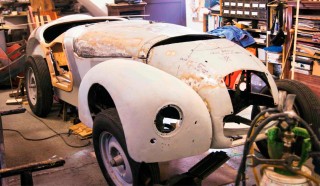
‘There was enough of the old frame to use as a pattern,’ he says, ‘but even so it still meant buying in a lot of new wood.’
Peter uses locally sourced English ash, and planks varying in thickness from an inch to three or four inches will usually do one frame.
He says, ‘You start with the sole plates – the heavy timbers fixed to the chassis. Every other piece fixes to these as you build it up.’
A lot of time-consuming craft is needed to create each piece before it takes its place as a finished part of the frame.
‘Every section started as a chunky bit of timber,’ says Peter. ‘It was fixed in place and then shapechecked against the old frame or panel, or other timbers already in place to give me a line. You make a mark along it, remove it, run it through the band saw and re-fit it. You make another comparison, then take it off and put it in the vice for planing. Finally, I refitted it once more and shaped it in situ to ensure the line of the frame flowed.’
The pieces are screwed together during this process then backed up with a PVA glue called Tightbond when it’s all assembled for the final time. ‘The Allard has a large cowl panel with a piece of 1/8 in rubber between it and the chassis,’ Peter says. ‘The body is fixed hard to that so the cowl panel needs to be extremely sturdy.’

The J1 was originally panelled in a mixture of aluminium and steel. Peter works in what amounts to a rural enclave of old car craftsmen near Brampton in Oxfordshire, so panel work was performed by Jack Lovegrove and further metalwork, preparation and paint by Mick Blewitt, both of whom are close enough to Clanfield Coachbuilding to share a communal coffee pot. Jack discovered that the aluminium in the rear body tub and doors had become extremely brittle. It could have been retained but would have suffered serious cracking so he decided to replicate it in new metal.
Creating the expanses of curved Allard tail section from a flat sheet of aluminium called for Lovegrove’s traditional wheeling and panel-beating skills. He made the rear tub up in sections, carefully gas-welded together and fitted over the frame.
The large steel sections – wings, bonnet, side panels and nose – all went off for blasting. They were all salvageable, but Mick propped it on four axle stands of equal height and measured the drop from each corner to the floor, before attempting a trial build and fit to see if it was as square as it should be.
Sure enough he found that the front crossmember was twisted – possibly as a result of the 1948 accident. He cut it out and re-welded it before sending the chassis off for blast cleaning – again – and refinishing.
Further months of chassis build-up followed to allow trial fitting of the body. Once Mick was happy with everything, he finished the shaping process with a high-build polyester primer, followed by several coats of epoxy primer.
‘We chose Old English White for the top coat but it looked too yellowy and creamy,’ says Mick. ‘So I tinted a base white and made up a custom colour that Patrick approved of.’ Seven coats later, the Allard was beginning to look like a car again.
For an apparently simple car, finishing it properly took a great deal of skill and resource. The grille, for instance, would originally have been handmade for this body.
HLP’s was missing, so Peter Baylis and fellow craftsman George Forbes made a new grille from pieces of flat brass bent on a plywood former. These were carefully joined with silver solder and finally chromed by Derby Plating. The correct headlamps, it turns out, are shared with a Routemaster RML bus.
Darrell Bryan did the retrim, working in close conjunction with Peter and Patrick. Patrick is tall and wouldn’t have been able to fit into the cockpit as it was when Imhof drove the car, so Peter created a floor with a drop to provide additional foot-room and lower the driver’s knees. Darrell then created the plywood seat frames, added foam and horse hair padding and finally trimmed them in leather, all to suit Patrick’s size and shape. Even the shape of the dashboard needed modification – moving one large dial to the centre created more vital room for the driver’s left knee.
Similar detail went into the mohair-trimmed hood. It’s based on an MGB frame, split and rebuilt high enough to clear the driver’s head and secured on doublelength studs that allow the tonneau to be fitted at the same time for additional warmth on solo journeys.
The finishing touch is the extraordinary trunk built by Clanfield’s Dave Mattingley.
Dave’s background in antique furniture helped him to come up with a modern solution to the twin problems of how to store the hood and where to stash luggage. Imhof had fitted a crude horizontal rack big enough for a couple of suitcases but the new creation is much more elegant. ‘I made a template of the end section based on the curve of the back seat on the body line,’ says Dave. ‘The hood frame needs to be stored when the hood is removed, so there’s a sliding box-drawer that locks with a hinge – this means it’s accessible without having to empty the trunk to get at it.’
Then disaster struck. Just when the restoration appeared to be nearing its conclusion, the engine suddenly and inexplicably suffered a bout of low oil pressure and subsequently spun a big-end bearing. It went back into service fitted with a pair of 30 AAPI Solex carburettors, Offenhauser cylinder heads and an Iskenderian Junior high-lift camshaft following a second rebuild over Christmas 2015.
Patrick White met the clever new luggage box for the first time on the day of our photoshoot. Visibly chuffed, he said, ‘It’s taken a long time, but the car is great fun to own and ready to do some serious miles. I can’t wait.’
Above: paintwork was custom-mixed to Patrick’s taste Left: mohair hood on a modified MGB frame is fully removable.
MY FAVOURITE TOOL
‘This is my DIY, but highly effective, method of lifting the transverse leaf front spring to be able to fit the shackle plates,’ says Mike Knapman. ‘I think at the time the spring was rated to 1100lb. Peter reduced it by trial and error to around the 850lb level, which works fine.’
‘I like spokeshaves,’ says Peter. ‘I have a brass one made by Lie-Nielson. One of my wooden ones was made in the 1940s, and I have a tiny one made from fine boxwood.
High point
‘Being able to research and find appropriate items such as instruments, lights and so on to make the finished car as near to how it was when it came out of the factory’
Handwritten notes on the nose helped to get Allard just right.
Dashboard had to be adapted to fit the tall current owner.
‘We wanted to restore the car as close to its as-new specification from 1946 as we could’
As discovered, the pile of bits looked daunting.
Low point ‘Dropping the newly rebuilt engine off the floor crane, which in turn broke a water pump and distorted the sump. Then hearing the big end give way when we were driving it on the A303’
Wooden frame uses locally sourced ash.





